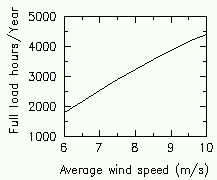| Project: Norwegian Wind Atlas | Customer: NVE/ENOVA | Revision: 2.0.0 | ||||||
| Scenario: - | User: VECTOR AS | Date: 01.05.01 | ||||||
| + | Energy calculations - onshore |
|
The energy production from a given area depends on the installed capacity and the number of full load hours.
The estimated energy production in this study is based on an installed capacity of 15MW/km 2. This installed capacity might be represented by 20 turbines with a nominal capacity of 750 KW, or by 6 larger turbines in the 2.5 MW class, situated within one square kilometre. Full load hours is an convenient notion expressing the number of hours which multiplied with the installed capacity will give the production during one year. The relation between full load hours and average wind speed has been taken as an average between four arbitrary wind turbines, with capacities ranging from 600 kW up to 1.8 MW, see table 1. |
| Wind speed | Full load hours | . | |||
| 6.0 | 1820.3 |  |
|||
| 6.5 | 2184.9 | ||||
| 7.0 | 2551.0 | ||||
| 7.5 | 2910.6 | ||||
| 8.0 | 3257.2 | ||||
| 8.5 | 3585.2 | ||||
| 9.0 | 3890.8 | ||||
| 9.5 | 4170.4 | ||||
| 10.0 | 4421.6 | ||||
| Table 1. | Full load hours versus wind speeds. |
|
The maximum theoretical energy production has been defined as the energy obtained from the area with wind speeds above 6.0 m/s. A simple extension of the above formula has been used where the areas have been grouped according to average wind speed. The full load hours for area 6 corresponds to an average wind speed of 6.5 m/s, and so forth.
|
| Figure 1. | Definition sketch for energy calculations. |
|
More refined energy calculations will require detailed information about the local wind fields, taking into consideration the wind speed distribution for each wind direction, and wake effects in the park. |